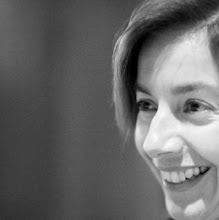My notes on
Andrea Fella's talk, on the Second Noble Truth, during the retreat:
We are conditioned to react to things of the world in terms of wanting, or not wanting. In that conditioning lies the direct cause of our suffering. The good news is, since reactivity happens in the mind, it can be changed.
Our culture, encourages that type of wanting, largely through advertising.
Classic Buddhist story of the hungry monkey, that is so attached to the idea of having sweet left inside hollow coconut, that it can't let go of grasping hand, and in doing so, is trapped, and cannot pull hand out through slit, through which it originally slid open hand. The monkey is trapped by its own craving. All it would take for it to be free, would be to open its hand and let go of the craving.
When we get what we want, we get a double hit of pleasantness:
1) getting what we want
2) having pain of wanting go away
We start to believe the only way to get happiness is to get what we want combined with release of the wanting. As the pleasure of the satisfied craving fades away, we want more of same thing, or we create more wants. This is a perpetual cycle.
Rilke's Fifth Elegy:
'But who are they, tell me, these Travellers, even more
transient than we are ourselves, urgently, from their earliest days
wrung out for whom – to please whom,
by a never-satisfied will? Yet it wrings them,
bends them, twists them, and swings them,
throws them, and catches them again: as if from oiled
more slippery air, so they land
on the threadbare carpet, worn by their continual
leaping, this carpet
lost in the universe.
Stuck on like a plaster, as if the suburban
sky had wounded the earth there.'
The Buddha recognized this was not very satisfying, and that a deeper happiness resulted from letting go of the craving. This requires a leap of faith. There are lots of opportunities for testing this out during a retreat. Of getting in touch with feelings of wanting, and the experience of unpleasantness associated with wanting itself. Realizing that wanting is dependent on causes. Also seeing that feeling of wanting eventually disappears, and leads to feeling of satisfaction. This can get tricky, as when we start looking for, wanting moment when wanting disappear.
Having a sense of curiosity is very helpful.
It is not about getting rid of wanting, but instead understanding it, and as we do, it will let go of itself.
Most obvious wantings, have to do with sense pleasures. There are also more subtle cravings, such as for feeling, or identity. This relates to teachings on dependent origination, including 12 steps, starting with contact experience, and resulting in suffering. Basically, each contact experience between the six physical senses and the mind, and the world, has a feeling tone, that is either pleasant, unpleasant, or neutral. This, combined with ignorance and misunderstanding, leads to craving or aversion. As we become aware of this process, we can retrain our mind. If we do not indulge these wantings and leave the mind alone, these wantings will start to shrivel.
Suffering and its causes happen in the present. Although it may appear that our suffering is a consequence from something that happened in the past, in reality, our suffering is the result from a present thought about a memory from the past, or an anticipated future. Our craving is about wanting a different past.
During the retreat, I did get plenty of opportunities to watch the cravings come, most of which could not be satisfied right there, and with them the associated suffering of the feeling of wanting itself. And then, pouf, on their own the wantings would go away, replaced by another craving. No need to indulge. Time took care of things, eventually:
Quick, out of the meditation hall,
to secure the sun-warmed stone path,
for my bare feet.
Walking meditation.
Craving, satisfied,
soon supplanted by hunger pain.
Anticipating the 5.15 dinner bell.
Unpleasantness of wanting,
not met, right now,
quickly forgotten.
Body starts to feel stiff;
I want to stretch on the lawn.
Ten minutes worth,
three cravings, right there.
Taking the high road, getting at the roots of suffering.












